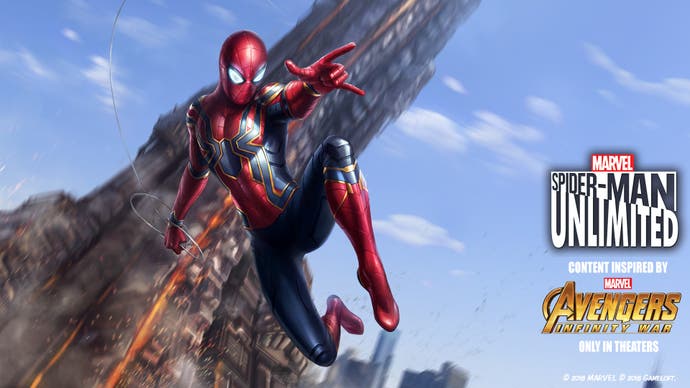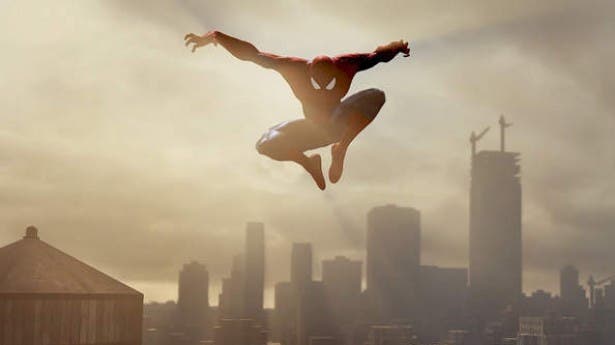Web history: a lifetime of playing Spider-Man
Thwip it up and start again.
If someone asks you to name the best Spider-Man game of all time, you don't need an uncanny, prickling spider-sense to intuit the answer. Unless the new PS4-exclusive blockbuster bash-em-up manages to set some stratospheric new benchmark - and since developers Insomniac have boldly messed with the classic costume design, they must be fairly confident - the answer will forever be 2004's Spider-Man 2.
It may have technically been a tie-in to the second Tobey Maguire movie but it felt more Spidey than Raimi, the first game to truly grasp that the essence of the character lay not in lightning-fast brawling combos or gumming up enemies with web-balls but by simply dropping Peter Parker into a New York City sand-and-skybox and gifting him the web-slinging skills to hurtle through, over, round and up its vertiginous skyscraper topography. The retrospective write-ups are as glowing as an irradiated arachnid, and rightly so.
So Spider-Man 2 is top of the heap and sometimes it really does look like a heap. There have been a ton of discarded or half-hearted Spidey games and it feels like I've played every single one, from all the Lego Marvel games to chunky co-op brawler Spider-Man: Friend or Foe. All the various installments that fail to meet Spider-Man 2's gold standard risk composting into one amorphous blob of red-and-blue tights and Stan Lee vocal cameos.

That would be a shame. The only other superhero so well-represented in gaming might be Batman but for all his singular focus and nifty gadgets, Bruce Wayne is just a man. With his preternatural powers Spider-Man is something more: he's amazing, spectacular, sensational. To examine the Spider-Man games of the last three decades is like reading a shadow biography of the character, a pass-the-parcel account of what various coders and designers and executives thought Peter Parker should represent, or be able to do, or just how best he could be sneakily squashed into the gaming conventions of the time.
One early but charming outlier is Empire Software's The Amazing Spider-Man, a 1990 release for 8-bit and 16-bit home computers. It dropped a teeny-tiny Spidey sprite into a non-scrolling platformer that - with its patiently patrolling killbots and myriad of switches to be tripped - felt more like Monty Mole or Jet Set Willy. The unrealistic screen layouts and eccentric baddies were all hand-waved away as the work of Mysterio, the movie special effects dude turned supervillain, but while the empty black backgrounds suggested a crew operating under a tight budget, this Spider-Man came fully specced.
His wallcrawling animation may have looked more like someone patiently doing squat thrusts but refreshingly there were absolutely no limits to where he could go. This pocket-size Spidey could walk up vertical walls and stroll along ceilings while a fully-functional 8-way web-swing could zip you across the entire length of the screen. Since your character was so small, it managed to feel surprisingly epic even though there wasn't a skyscraper in sight.

On consoles, Peter Parker seemed to spend the 1990s stranded in a rash of side-scrolling beat-em-ups and arcade platformers, sturdy but boilerplate games that might throw in the odd bit of wallcrawling but were mostly focused on the beatdown. Patrolling the streets of New York city duffing up muggers certainly fits with the established backstory of the character but looking back, what stands out is Spidey's ramrod posture.
These were games that dove headlong into the comicbook continuity - adapting berserk, byzantine Marvel storylines like Maximum Carnage - yet the console Spider-Men of this era all seemed to walk with the stiff-backed gait and puffed-out chest of a Double Dragon or Golden Axe sprite, almost as if you could throw any arcade hero in there. While many of these games were satisfying to plough through you rarely got the sense of a striving teen who cracked wise from behind his mask to hide his insecurities about being a crimefighter.
Perhaps it helps when Spidey is in an ensemble cast. When developing their Marvel Super Heroes one-on-one arcade fighter in the early 1990s, Capcom took visual inspiration from Todd McFarlane, the superstar artist who had emphasised Spider-Man's insectile side by reimagining his physicality as that of a slightly unnerving contortionist rather than a strapping hero. This twitchy version of the character, constantly hunched over in spindly, nervy repose, has survived through various Capcom games all the way to 2017's Marvel Vs Capcom Infinite (where his seasoned Maximum Spider special remains a banger).
Under the mercantile auspices of publisher Activision, the 2000s were a gold disc age for Spider-Man games, a period where the runaway success of Sam Raimi's movie trilogy and a flurry of console releases seemed to complement each other. That Venom-like symbiosis even manifested in the real world, with some Sony/Columbia executive clearly deciding that the first Spider-Man movie and the original PlayStation 3 deserved to share the same branding font.

After the success of Spider-Man 2, subsequent games seemed to offer spins on the same core concept of swinging round New York City. In the cartoony Ultimate Spider-Man, there was a distinctive, inky art style but a notably simplified webslinging mechanic. In the gloomy Spider-Man: Web of Shadows, the Big Apple slowly succumbed to an alien infestation that clogged up the skyline and turned citizens into skittering, wall-crawling zombies. These games were, for the most part, competently produced and enjoyable to play but couldn't help but feel like minor variations on a recurring Spider-theme: same thwip, different day.
After the open-world triumph of Grand Theft Auto 3 - a huge influence on Spider-Man 2 - Rockstar could easily opt to swap out central characters or move cities with subsequent instalments. For better or worse, Spider-Man felt increasingly yoked to his hometown. In 2010, developers Beenox successfully shook things up with Shattered Dimensions, a game that tapped up four different Spider-Men from across the Marvel multiverse. Suddenly Spidey was untethered from NYC and off the leash, even if most of the missions unfolded in enclosed environments. Still, it was worth it to see Spider-Man 2099, a far-future favourite of mine with a gnarly costume and a notably more ruthless streak, share topline billing in both Shattered Dimensions and its rapid-fire sequel Edge of Time.
The resumption of the movie franchise in 2012 prompted a soft gaming reboot to the Spider-Man 2 template of swinging round NYC and while The Amazing Spider-Man feels like a listless next-gen leap - with a notably bigger character model and the ability to freeze time and cinematically zip to predetermined anchor points - the best thing about it was Gerard Marino's soundtrack, which managed to be more memorable than the one James Horner composed for the actual movie. Rightly or wrongly, no-one seemed particularly interested in 2014's Amazing Spider-Man 2 movie sequel - even though it featured the best on-screen version of the costume to date - and the accompanying game was similarly half-hearted, with a distractingly chunky UI seemingly designed with the Early Learning Centre in mind.
So after 30 years, Spider-Man 2 is still the champ, by some margin. But if I had to choose a silver medal, it would probably go to Spider-Man Unlimited, a freemium game for smartphones that recently celebrated its fourth birthday. It is a bright, bouncy, insinuatingly addictive endless runner that is steeped in the absurd multiverse of Spider-Man lore, from the Bombastic Bag Man (when poor Peter had to borrow a spare Fantastic Four costume and put a brown paper bag on his head) to the oinktastic Spider-Ham. Collecting all of its 414 (and counting) characters will likely take me a lifetime or cost me a fortune or both, but it provides a hit of Spider-Man in his purest form: swinging, quipping, stumbling but always striving.

